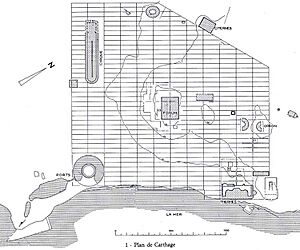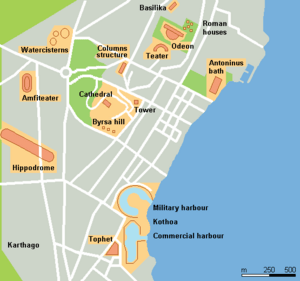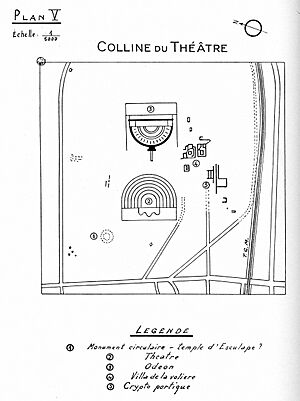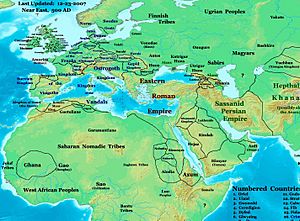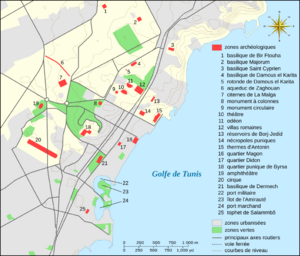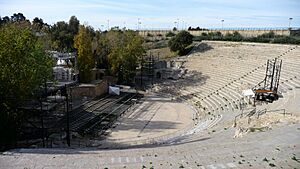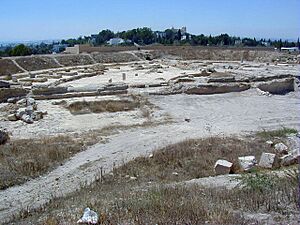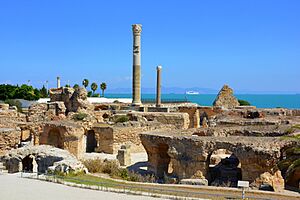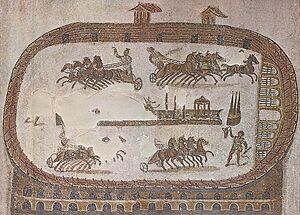Roman Carthage facts for kids
Roman Carthage was a very important city in ancient Rome. It was located in what is now Tunisia.
About 100 years after the old city of Punic Carthage was destroyed in 146 BC, the Romans built a new city. They named it Carthage (in Latin Carthāgō). This happened between 49 and 44 BC. By the 3rd century, Carthage had grown into one of the biggest cities in the Roman Empire. Hundreds of thousands of people lived there. It was the main city of the Roman province called Africa. This province was a huge supplier of grain for the empire.
Carthage was briefly the capital for a ruler named Domitius Alexander from 308 to 311 AD. The Vandals conquered it in 439 AD. Carthage then became the capital of the Vandal Kingdom for 100 years. The Eastern Roman Empire took it back in 533–534 AD. It remained an important Eastern Roman center. It was the seat of the praetorian prefecture of Africa and later the Exarchate of Africa.
Umayyad Arab forces attacked and destroyed the city after the Battle of Carthage in 698 AD. They did this to stop the Byzantine Empire from taking it back. A fortress on the site was guarded by Muslim forces. Later, during the Hafsid period, Crusaders captured it during the Eighth Crusade. After the Crusaders left, the Hafsids destroyed the fortress. They wanted to prevent enemies from using it again. Roman Carthage was also used as a source of building materials for cities like Kairouan and Tunis in the 8th century.
Contents
History of Roman Carthage
How Carthage Was Founded
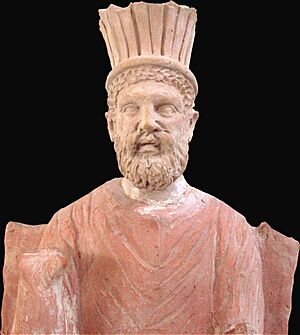
After Rome conquered Carthage, its nearby rival, Utica, became the capital. Utica was an ally of Rome. For a while, it replaced Carthage as the main center for trade. Utica was in a good spot, at the mouth of the Medjerda River. This is Tunisia's only river that flows all year.
However, growing grain in the Tunisian mountains caused a lot of silt to wash into the river. This silt filled up Utica's harbor, making it useless. So, Rome started looking for a new harbor town.
In 122 BC, Gaius Gracchus started a short-lived Roman colony called Colonia Junonia. The idea was to give farmland to poor farmers. But the Senate later ended the colony. They wanted to reduce Gracchus's power.
After this attempt failed, Julius Caesar built a new Carthage. It was on the same land as the old city. This happened between 49 and 44 BC. By the first century, it was the second-largest city in the western Roman Empire. At its busiest, it had about 500,000 people. It was the main city of the Roman province of Africa. This province was a major source of food for the empire. One of its big buildings was the amphitheater.
The Temple of Juno Caelestis was one of Carthage's largest buildings. It was dedicated to Juno Caelestis, the city's protector goddess. It became a holy place for people from all over North Africa and Spain.
Early Christianity in Carthage
Carthage became an important center for early Christianity. In one early meeting, over 70 bishops attended. Tertullian was a Christian writer from Carthage. Later, Christians in Carthage faced a big disagreement called the Donatist controversy. Augustine of Hippo spent a lot of time writing against it. At the Council of Carthage (397), the list of books for the Christian Bible in the Western Church was confirmed. Christians in Carthage also took part in persecuting pagans. During this time, pagan temples, including the Temple of Juno Caelestis, were destroyed.
A large fire in the second century helped reshape a hilly part of the city. A big area of fancy homes, like the "Villa de la volière," was built there. A round monument, found during a UNESCO project, might have been a tomb from the Christian period. A large inscription to Aesculapius was found nearby. This suggests the Punic temple of Eshmun was on this site. Texts say the Romans built a temple to their similar god there. A large entertainment area was also built. It had a theater from the second century and an odeon from the third century.
The Vandal Period
The Vandals, led by Gaiseric, arrived in the Roman province of Africa in 429 AD. They may have been invited by a Roman general, or they came looking for safety. They fought the Roman forces and by 435 AD, they had won. They then set up the Vandal Kingdom. Gaiseric was an Arian Christian. This was different from the Catholic Christians. But he promised religious freedom, which might have made the city's people accept him.
A 5th-century Roman bishop, Victor Vitensis, wrote that the Vandals destroyed parts of Carthage. This included buildings and churches. Once in power, the Vandals treated church leaders badly. They taxed the local people heavily. They also launched naval raids on Romans in the Mediterranean Sea.
The Byzantine Period
After two failed attempts by Roman emperors to take back Carthage, the Byzantine (Eastern Roman) Empire finally succeeded. They used the removal of Gaiseric's grandson, Hilderic, by his cousin Gelimer as a reason for war. The Roman general Belisarius conquered the Vandals in the Vandalic War of 533–534 AD. Belisarius entered Carthage in October 533 AD.
For the next 165 years, Carthage was the capital of Byzantine North Africa. It was first called the praetorian prefecture of Africa. Later, it became the Exarchate of Africa under Emperor Maurice. These two regions, along with the Exarchate of Ravenna, were the last strongholds of the Byzantine Empire in the West. In the early 7th century, Heraclius the Elder, the leader of Africa, rebelled against the Byzantine emperor Phocas. His son Heraclius then became the emperor.
Islamic Conquest
The Exarchate of Africa first faced Muslim expansion from Egypt in 647 AD. This attack did not last long. A longer campaign happened from 670 to 683 AD. But it ended with a Muslim defeat. Carthage was captured by Muslims in 695 AD. The Byzantines took it back in 697 AD. But it was finally conquered in 698 AD by the Umayyad forces of Hassan ibn al-Nu'man.
The Umayyads feared the Eastern Roman Empire might take it back. So, they decided to destroy Roman Carthage completely. They used a scorched earth policy. They moved their government center further inland to Tunis. The city walls were torn down. The water supply was cut off. Farmland was ruined, and its harbors were made unusable. The destruction of Roman Carthage ended Roman rule in the region. This rule had been in place since the 2nd century BC.
Archaeological finds show that people continued to live in Carthage. The Baths of Antoninus were still used during the Arab period. The historian Al-Bakri said they were still in good condition. It is hard to know if other buildings were used in the late Byzantine or early Arab times. The Bir Ftouha church might have been used for a while. Constantine the African was born in Carthage.
Muslims continued to use the fortress of Carthage until the Hafsid era. Christian forces captured it in 1270 AD during the Eighth Crusade. After the Crusaders left, Muhammad I al-Mustansir decided to destroy it completely. He wanted to prevent it from being used by enemies again.
Rediscovery of Carthage
The ruins of Carthage were found again in the late 1800s. The Odeon was dug up in 1900–1901. The amphitheater was excavated in 1904.
Odeon Hill and Roman Villas
Odeon Hill is in the northeast part of the Carthage archaeological site. It has many Roman ruins. These include the theater, the odeon, and the park of the Roman villas. The park has the villa of the aviary. This is the best-preserved Roman villa at Carthage.
The House of the Horses has a mosaic with over fifty circus horses. It also shows hunting scenes around the edges.
Odeon Hill got its name because people thought a building there was the Odeon. This building was known from writings by Tertullian. But it turned out to be a theater. Odeon Hill and the park of the Roman villas are east of the Roman colony of Carthage. They are north of the park of the Baths of Antoninus. The presidential palace is now to the south of this area. The Mâlik ibn Anas mosque has been built to the north.
The Theatre
Tertullian wrote about the theater's rich decorations. He mentioned the beautiful marble seats, the stage floor, and the tall pillars. There were marble and porphyry columns at the back of the stage. There were also many statues and fine carvings. The theater covers an area about the size of four city blocks. It was probably built around the time of Augustus. It is the second-largest Roman theater in Africa. Only the one in Utica is bigger.
Pieces of writing found in the theater mention repairs made in the fourth century.
The theater mixes Greek and Roman styles. The seating levels are supported by arches. But they also use the natural slope of the hill. The cavea had sections of seats separated by stairs. The orchestra area had more comfortable, movable seats for important guests. A wall separated the orchestra from the stage. The back of the stage formed the building's backdrop. The odeon was built entirely above ground. It did not use the hill's slope.
Very few Roman parts of the stands remain today. The theater was rebuilt. Since 1964, it has been the site of the International Festival of Carthage. The semicircular walls also date from the early 20th century. They were used for costume making.
The Odeon
Only parts of the Odeon's foundations remain. They were barely uncovered in the early 1900s. Paul Gauckler rediscovered it. He led digs between 1900 and 1901. The Christian writer Tertullian mentioned the Odeon. It is where the Roman Emperor Septimus Severus, who was from Africa, gave a prize. This prize was for the winner of a literary competition.
The Odeon is thought to be the largest Roman Odeon. It is next to the southern theater and covers three city blocks. It could hold about 20,000 people. It was not thought to be an Odeon until an inscription "ODEVM" was found. This was in a water tank under the stage. For comparison, the second-largest Roman Odeon in Athens held 5,000 people.
More digs happened between 1994 and 2000. Researchers from the University of Waterloo and Trinity University worked there. The site is now very close to the Mâlik ibn Anas Mosque. The building was next to the theater and built entirely above ground. It had curved hallways for visitors to walk through. Tertullian mentioned finding burial sites when the building was being built. Timothy Barnes believes it was built around 200 BC.
Roman Villas
The remains of the villas are not in great shape. But the villa of the aviary is an exception. The main interesting part of this area is seeing a neighborhood of the Colonia Iulia Carthago. It was organized into insulae, which were small blocks of 35 by 141 meters.
This second-century neighborhood had straight streets. The buildings were "successive tiers crammed into the sides of the hill." The upper level was built into the ground. The lower level opened onto the street below it. The apartments were on the upper floor. Shops were on the ground floor at street level.
The villa of the aviary is the main feature of the park. This is because it was restored very well in the 1960s. The villa's name comes from its mosaic of an aviary. This mosaic shows birds among leaves. It is in the garden, in the middle of the viridarium. This was the heart of a square courtyard with a portico (covered walkway) decorated with pink marble pillars.
To the southwest is a terrace that opens onto the street. To the west, a vaulted gallery helps support the ground. The building's atrium is to the east. To the north are all the important rooms. These include the fancy apartments, the laraire (shrine), and the vestibule (entrance hall).
Upstairs were the baths and shops. On the upper floor were the owners' private apartments. Shops were under the terraced portico. Below the cryptoporticus (covered walkway) was a sheltered path.
Baths of Antoninus
The Baths of Antoninus, or Baths of Carthage, were the largest Roman thermae (public baths) built in Roman North Africa. They were also one of the three largest in the Roman Empire. They are the biggest outside mainland Italy. These baths are the only remaining large baths in Carthage from the Roman Empire's era. They were built when Roman Emperor Antoninus Pius was in charge. The baths were still used during the Arab period. The historian Al-Bakri said they were still in good condition.
The baths are in the southeast of the archaeological site. They are near the presidential Carthage Palace. Digs started during World War II. They led to the creation of an archaeological park for the monument. It is also one of the most important landmarks of Tunisia.
Circus of Carthage
The Circus of Carthage was built like the Circus Maximus in Rome. It was over 470 meters long and 30 meters wide. It could hold up to 45,000 people. This is about one-third the size of the Circus Maximus. It was used for chariot racing.
The building seems to have been built around 238 AD. It was used for several years before it was officially dedicated.
Parts from the Circus Maximus, like the marble "spina" (a dividing barrier), were used in the Circus of Carthage. They were also used in the Circus of Maxentius and the city of Vienne in France.
See Also
- Bardo National Museum
- Baths of Antoninus
- Carthage National Museum
- Carthage Paleo-Christian Museum
- Carthage
- History of Carthage


